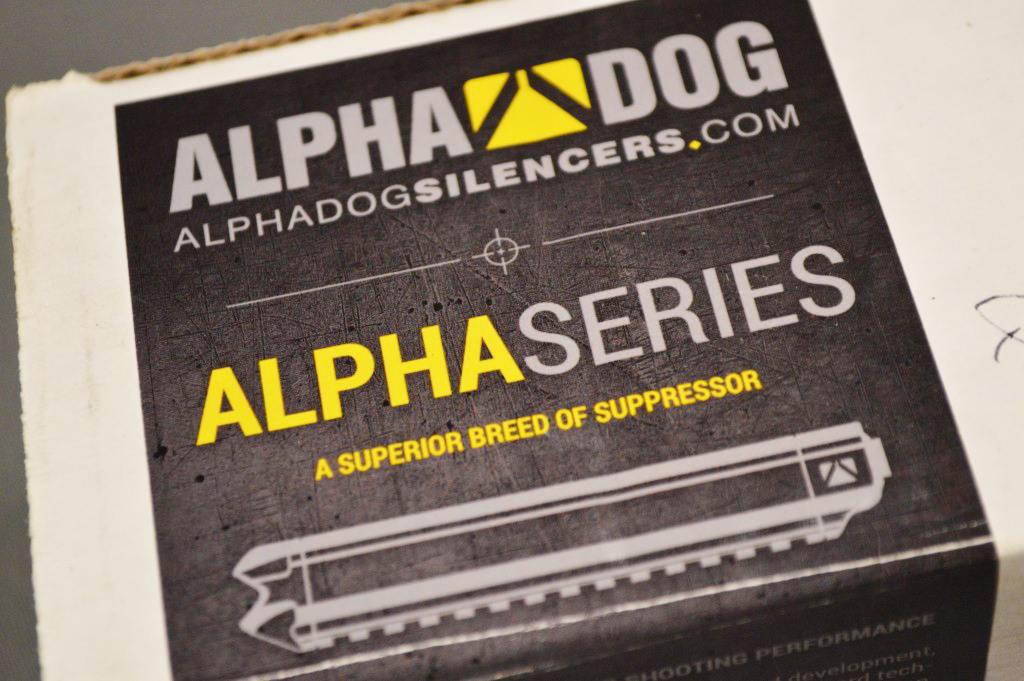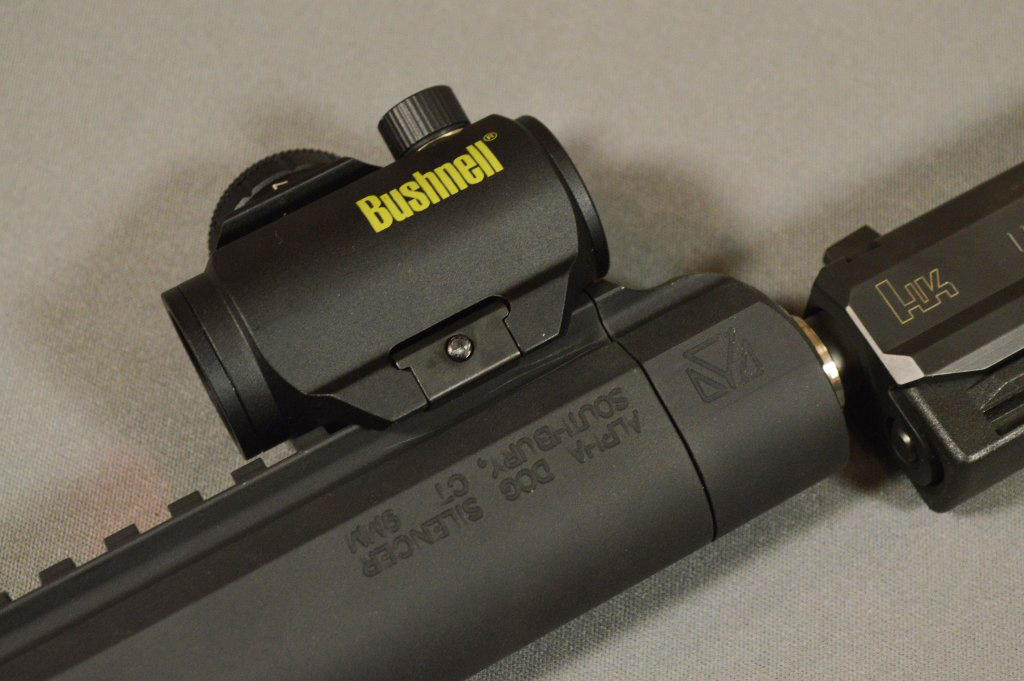Silencer Shop Authority: Reviewing Alpha Dog’s Alpha 9 Suppressor
The past few years have been extremely good for suppressor enthusiasts and manufacturers. Despite the threat posed by ATF 41F, the sheer numbers of silencers in public hands have exploded, and in response to this growth, we’ve seen plenty of new companies hop in for a piece of the pie.
A few of these newcomers happen to be cranking out some very unique products. Dead Air Armament might be run by industry veterans, but they’re among the first to bring an AK-specific silencer to the mass market. Rebel Silencers has just announced a tubeless 5.56mm suppressor that can be configured for five different lengths. And then we come to the topic of today’s discussion – Alpha Dog’s Alpha 9 suppressor – a 9mm silencer with a Picatinny rail.
You can probably understand the skepticism I felt when I first saw the Alpha 9. Alpha Dog is a new company, and I couldn’t help but wonder if the can was a worthy entrant or a total gimmick. However, I know better than to dismiss something like this out of hand and as crazy as it seemed at the time, I did find the rail somewhat intriguing. After contacting my friends at Silencer Shop, I was able to take the Alpha 9 to the range last weekend.
Size & Weight
Despite its oddball shape, the Alpha 9 isn’t as large as it might look. Positioned with the rail either up or down in relation to the host gun, the silencer is approximately 1.64″ tall and 1.28″ wide. That isn’t much larger in overall size than a traditional 9mm silencer; the volume just happens to be distributed differently. The can is exactly 7.5″ long, which is also on par with other 9mm silencers.
Materials & Design
Excluding the piston, the Alpha 9 is entirely constructed of 6005-T6, 6061-T6, and 7075-T6 aluminum. Perhaps unsurprisingly, this leaves the baffled core as the stronger 7075 part and the end caps as 6061-T6. The outer body of the suppressor is where you’ll find the 6005-T6 aluminum and the pistons are 17-4 stainless steel.
Some might complain that Alpha Dog’s extensive use of aluminum limits cleaning options. Indeed, ultrasonic cleaners and ammonia-based agents will damage the suppressor, but you don’t need to get this can as spotless as some might think. Just a quick scrub to get the larger particles out of the core should be sufficient.
Unlike literally every other silencer I’ve seen, the Alpha 9 features a Picatinny rail that is integral to its outer body. Newer versions also come with integrated iron sights. The rail allows end-users to mount lights and lasers, or even red dots to the can. No matter how you look at it, the Alpha 9 is unique.
Since I am talking about cleaning, I really should call attention to the fact that the Alpha 9 is unquestionably the most difficult suppressor to take apart that I’ve tested to date. I’m not kidding, this thing can be a real chore to take down. According to the manual, you need to partially unscrew the piston retainer and then grasp the body of the can while pushing down on the piston assembly. The body and rear cap are separate pieces, while the piston assembly, core, and front cap are all one unit. Pressing down on the piston retainer dislodges the core and allows it to slide out the front of the tube. You’ll probably need a rubber mallet to get it apart and putting it back together isn’t much easier.
Range Report
Despite the company’s name, the Alpha 9 is no dog in the performance category. Alpha Dog lists the can at 124 dB when paired with a SIG P226 and 147 grain subsonic ammo. That’s too close to category leaders like the Ti-Rant 9 and Osprey 9 in my opinion, but I’m quite confident that it performs as well as the AAC Illusion 9, which Silencer Shop found was capable of suppressing an M&P 9mm to around 127 dB. The Alpha 9 is definitely an enjoyable silencer to use and I was wrong to think that its odd design meant that it could not also be a respectable performer.
First round pop (FRP) was much less noticeable than I expected. Generally, the first few rounds through monocore suppressors are quite a bit louder than those fired through stacked baffle designs. I would say at worst, the Alpha 9 offers 5 dB of FRP. It seems that the reduced-size blast chamber helps to minimize the surplus oxygen that leads to FRP.
Much of the Alpha 9’s appeal obviously comes from the fact that it sports a Picatinny accessory rail that is capable of accepting either a flashlight/laser or red dot, depending on how you orient the silencer upon mounting. To facilitate proper rail indexing, the Alpha 9 can be rotated once mounted by pulling forward on its body, rotating the silencer, and allowing it to drop back down into one of the piston’s grooves. This method is commonly used by round silencers, but it isn’t ideal for eccentric ones. Since the Alpha 9 can only be adjusted in 30-degree increments, I could not find a position that would center a red dot above my USP’s bore. Alpha Dog should have used an Osprey-esque locking gate to support finer adjustments. As the Alpha is designed, don’t be surprised if you need to add a washer or two to find an acceptable index point.
My indexing gripes aside, the Alpha 9 does work exactly as advertised. For experimentation purposes, I mounted my Bushnell TRS-25 red dot on the can and proceeded to fire a magazine without stoppage. I couldn’t zero the red dot, but I did want to check for function. The pairing makes for a heavy gun (the TRS-25 and Alpha 9 combine to weigh around 15.3 ounces), but it was more manageable than I expected and it did work reliably. Alpha Dog certainly isn’t blowing smoke that the silencer can be used this way.
A final noteworthy point is that the Alpha 9 had a tendency to work itself loose on my RCM USP threaded barrel. It didn’t take many rounds to do so, either. After each magazine, I needed to snug the suppressor back down to the barrels shoulder. While this was an annoyance, I can’t exactly blame the suppressor. Even for a specified pitch, thread specifications can vary fairly significantly. Sometimes you simply run into threads that are on different ends of the specs and don’t want to play together nicely. If this were my personal suppressor, I would probably apply a tiny amount of Rocksett or Teflon tape to the barrel threads before hitting the range.
Conclusion
Ever since I pitted AAC’s Illusion 9 and SilencerCo’s Osprey against one another, I’ve had a real soft spot for eccentric silencers. I always love to see suppressor companies trying new things and by adding a Picatinny rail to a can, Alpha Dog has done exactly that. And as it turns out, the Alpha 9’s rail happens to be far more usable than I anticipated.
I did run into some minor issues. Namely, the silencer is difficult to disassemble and it wanted to loosen on my USP. However, the challenges aren’t insurmountable. On the flip side, the Alpha 9 sounds better than I thought it would and it is actually relatively slim for the design.
An information security professional by day and gun blogger by night, Nathan started his firearms journey at 16 years old as a collector of C&R rifles. These days, you’re likely to find him shooting something a bit more modern – and usually equipped with a suppressor – but his passion for firearms with military heritage has never waned. Over the last five years, Nathan has written about a variety of firearms topics, including Second Amendment politics and gun and gear reviews. When he isn’t shooting or writing, Nathan nerds out over computers, 3D printing, and Star Wars.














